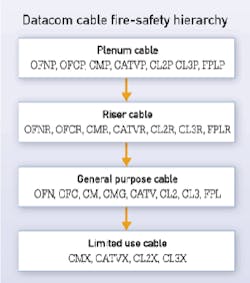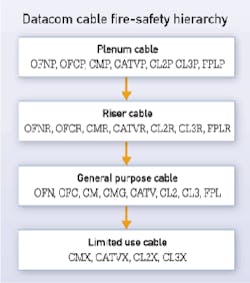What the 2011 NEC says about datacom cable and raceways
The product types are organized into a hierarchy of fire safety.
By Stanley Kaufman, CableSafe Inc.
The National Electrical Code (NEC) is published by the National Fire Protection Association (NFPA; www.nfpa.org) with revisions on a three-year schedule. The 2011 NEC, which replaces the 2008 NEC, was released by the NFPA in August 2010. There were many changes of interest to manufacturers, installers and users of communications cable and connectivity products.
This is the first in what is planned to be a series of nine articles that I will write on behalf of the Communications Cable and Connectivity Association (CCCA; www.cccassoc.org). This article’s objective is to provide a basic understanding of how the NEC is organized, including some of the key terms, definitions and fire-safety relationships that apply to communications cables. It is intended to serve as a foundation for the ensuing eight planned articles.
Chapters and Articles. The NEC is organized into nine chapters. For example, one chapter is titled “Chapter 8, Communications Systems.” The nine chapters of the NEC are divided into subsections called Articles. Examples of articles within Chapter 8 that are important to the data-communications industry are Article 800, Communications Circuits and Article 770, Optical Fiber Cables and Raceways.
Scope and organization. The NEC covers communications equipment, wires and cables installed in most buildings. It also includes optical-fiber cables and raceways. It exempts communications equipment installations in telephone-company central offices where the installation is under the exclusive control of a communications utility; however, it does not exempt communications equipment in a telephone switching office run by a nonutility such as a large university or nonutility provider of telephone service.
Significantly, the communications chapter (Chapter 8) of the NEC is independent of the rest of the code. Only those electrical wiring requirements in Chapters 1 through 7 that are specifically referenced in Chapter 8 are applicable to Chapter 8. One example is that the cable-tray fill requirements in Article 392 (Cable Trays) do not apply to installations of communications (telephone) cables (Type CMP, CMR and CM) covered by Chapter 8. They do apply to installations of data cables (Class 2 cables, Types CL2P, CL2R and CL2) because these cables are in Article 725.
Data-communications cables
Although widely used in the industry, the term “datacom” does not appear in the NEC. The term datacom cable, as we will use it in this article and future articles, encompasses six families of cable types in the NEC.
- Optical fiber cables, Types OFNP, OFCP, OFNR, OFCR, OFN and OFC
- Communications cables, Types CMP, CMR, CMG and CM
- Coaxial cable-TV cables, Types CATVP, CATVR and CATV
- Class 2 cables, Types CL2P, CL2R and CL2
- Class 3 cables, Types CL3P, CL3R and CL3
- Power-limited fire-alarm cables, Types FPLP, FPLR and FPL
Datacom cable fire-safety hierarchy. The hierarchy of fire-safety performance of datacom cables is illustrated on page 7. Although the hierarchy has four levels, the lowest levels—Type CMX for example—have restricted uses (one- and two-family residences), so we will not consider them to be datacom cables. Besides the vertical fire-safety hierarchy, there is a horizontal substitution hierarchy, with communications cables permitted to be substituted for other cables. Type CM general-purpose communications cable is permitted to substitute for Type CL2 and CL3, Class 2 and Class 3 general-purpose cables and Type FPL power-limited fire-alarm cable. Coaxial Type CM is permitted to substitute for Type CATV. (All the CATV cables are coaxial.)
Combining the vertical hierarchy and the horizontal cable substitutions, Type CMP plenum communications cable is permitted as a substitute for all communications, Class 2, Class 3 and fire-alarm cables, and also as a substitute for all coaxial CATV cables. For fire safety, type CMP is the universally acceptable metallic conductor datacom cable.
Optical-fiber cables are available in nonconductive (all-dielectric) and conductive (with a metallic strength member or metal armor) versions. Nonconductive optical-fiber cables are permitted to substitute for conductive optical-fiber cables at the same or lower levels on the hierarchy scale. Type OFNP is the universal optical-fiber cable.
Data-communications raceways
Various terms including raceway, duct, conduit and innerduct are used to describe pipe-like structures in which cables are installed. The 2011 NEC defines a raceway as follows. Raceway. An enclosed channel of metal or nonmetallic materials designed expressly for holding wires, cables, or busbars, with additional functions as permitted in this Code. Raceways include, but are not limited to, rigid metal conduit, rigid nonmetallic conduit, intermediate metal conduit, liquidtight flexible conduit, flexible metallic tubing, flexible metal conduit, electrical nonmetallic tubing, electrical metallic tubing, underfloor raceways, cellular concrete floor raceways, cellular metal floor raceways, surface raceways, wireways, and busways.
The key words in the definition of a raceway are “enclosed channel.”
The NEC does not define conduit, but each individual conduit has a definition; most of these definitions include the words “a raceway of circular cross section.” Raceways with circular cross sections are conduits.
The NEC uses the terms “duct” or “electrical duct” without definition; they are raceways.
The 2011 NEC defines optical-fiber and communications raceways. They are specialized nonmetallic raceways, and their definitions are below.
Optical Fiber Raceway. An enclosed channel of nonmetallic materials designed for holding optical fiber cables in plenum, riser, and general-purpose applications.
Communications Raceway. An enclosed channel of nonmetallic materials designed for holding communications wires and cables in plenum, riser, and general-purpose applications.
The 2011 NEC permits optical-fiber raceways to be installed inside of other raceways as innerduct. Although innerduct is not yet defined in the NEC, it is clear that innerduct is a raceway that is installed inside of another raceway. Unfortunately, optical-fiber and communications raceways are often referred to as “innerduct” even if they are not installed inside another raceway or conduit.
The NEC addresses three kinds of datacom raceways: signaling (Article 725), optical fiber (Article 770) and communications (Article 800). Each is available in plenum, riser and general-purpose grades, with the same hierarchy as the cables.
Enforcement and interpretation
The NEC is intended to be adopted as law by governments, typically cities, counties and states. Because it is enforceable by law, it can affect matters such as occupancy certificates and legal liability in the event of noncompliance. Interpretation of the Code is the responsibility of the authority having jurisdiction, which is usually an electrical inspector.
You now should have a fundamental understanding of some of the key terms and concepts that apply to communications cables, and will be described in further detail in future articles.
Author’s disclaimer: This article, written on behalf of the Communications Cable and Connectivity Association (CCCA), is offered for general information and educational purposes. It is not offered, intended, nor should it be relied upon as legal advice. The article does not set forth the views of any member of any other party, nor may it be taken as such. CCCA makes no warranty regarding the accuracy of the information provided in this article, and expressly disclaims any implied warranties and any liability for use of the article or reliance on views expressed in it. CCCA does not endorse, approve or certify any information set forth in this article, nor does it guarantee the accuracy, completeness, efficacy, timeliness or correct sequencing of such information. Use of this article and the views expressed in it is voluntary, and reliance on it should only be undertaken after an independent review of its accuracy, completeness, efficacy and timeliness, and based on the individual facts and circumstances of a user.
Stanley Kaufman, Ph.D. is principal of CableSafe Inc. and a consultant to the Communications Cable and Connectivity Association (CCCA; www.cccassoc.org).


